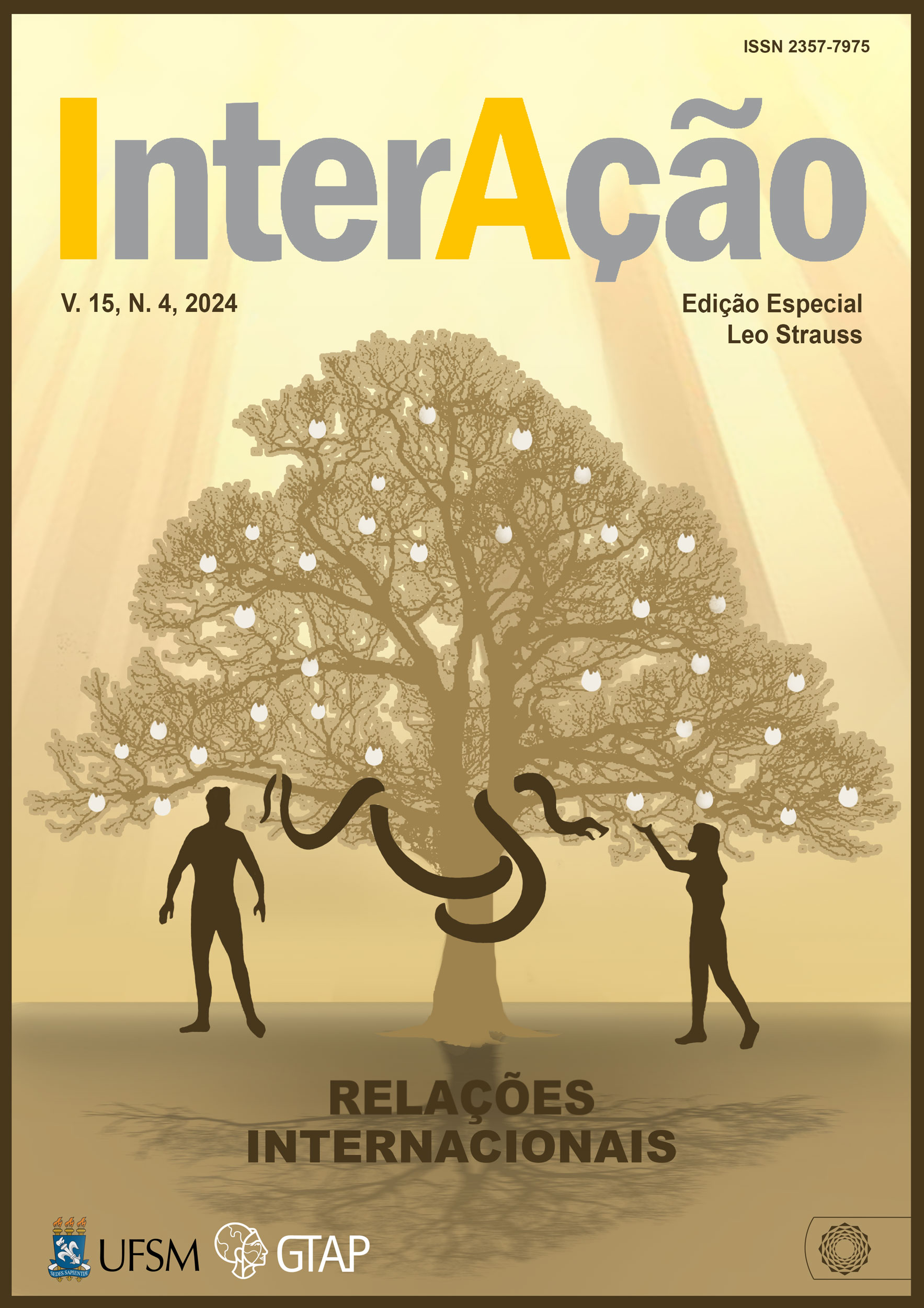Securitization and desecuritization of coca leaves in the Andean Amazon: the United Nations (UN) in Bolivia
DOI:
https://doi.org/10.5902/2357797588678Keywords:
Securitization, Desecuritization, Coca leaf, UNODC, Bolivian AmazonAbstract
This article explores the process of securitization and desecuritization of coca leaves in the Bolivian Amazon, focusing on the role of the UN, particularly the UNODC. The research analyzes how coca leaves, deeply rooted in Andean culture, were transformed into an international security issue due to their association with cocaine production. The article employs the securitization theory from the Copenhagen School to understand how the UN positioned coca leaves as a threat and the implications of this for Andean countries. The methodology includes a literature review and a case study of Bolivia, with a qualitative content analysis. The results indicate that while coca leaves have historically been securitized, the monitoring conducted by UNODC has contributed to their desecuritization by providing data that deconstructs their image as a global threat. The study concludes that despite progress, the desecuritization process still faces significant challenges, particularly in the context of drug trafficking in South America.
Downloads
References
ANTONIL. Mama Coca. Londres, England: Knockabout, 1978. DOI: https://doi.org/10.1080/02791072.1978.10472071
BAHLS, F. C.; BAHLS, S.C. “Cocaína: origens, passado e presente”. Interação em Psicologia, vol. 6, n. 2, 2002. DOI: https://doi.org/10.5380/psi.v6i2.3305
BALZACQ, T. et al. “The ‘Essence’ of securitization: Theory, ideal type, and a sociological science of security”. International Relations, vol. 29, n.1, march, 2015. DOI: https://doi.org/10.1177/0047117814526606b
BARRETO, I. F. “O uso da folha de coca em comunidades tradicionais: perspectivas em saúde, sociedade e cultura”. História, ciências, saúde, vol. 20, n. 2, abril-junho, 2013. DOI: https://doi.org/10.1590/S0104-59702013000200015
BOLÍVIA. Monitoreo de Cultivos de Coca 2011. La Paz, Estado Plurinacional de Bolivia, 2012. Disponível em: https://www.unodc.org/documents/crop-monitoring/Bolivia/Bolivia_coca_survey_spanish_2012_web.pdf. Acesso em: 03/11/2023.
BOLÍVIA. Monitoreo de Cultivos de Coca 2021. La Paz, Estado Plurinacional de Bolivia, 2022. Disponível em: https://www.unodc.org/documents/crop-monitoring/Bolivia/Bolivia_Monitoreo_de_cultivos_de_coca_2021.pdf. Acesso em: 03/11/2023.
BUZAN B.; HANSEN, L. A evolução dos Estudos de Segurança Internacional. São Paulo: Editora Unesp, 2012.
BUZAN, B.; WAEVER, O.; WILDE, J. Security: A New Framework for Analysis. Boulder: Lynne Rienner Publishers, 1998. DOI: https://doi.org/10.1515/9781685853808
COSKUN, B. B. “Analysing desecuritisations: prospects and problems for Israeli–Palestinian reconciliation”. Global Change, Peace & Security, vol. 20, n. 3, december 2008. DOI: https://doi.org/10.1080/14781150802394337
COSTA, C. “Amazônia: O que ameaça a floresta em cada um de seus 9 países?”. BBC [18/02/2020] 2020. Disponível em: https://www.bbc.com/portuguese/brasil-51377232#:~:text=Juntamente%20com%20a%20mineração%2C%20a,%2C%20território%20ultramarino%20da%20França). . Acesso em: 28/10/2023.
DUQUE, M. G. “O Papel de Síntese da Escola de Copenhague nos Estudos de Segurança Internacional”. Contexto Internacional, vol. 31, n. 3, dezembro, 2009. DOI: https://doi.org/10.1590/S0102-85292009000300003
FRANCOVICH, G. Os mitos profundos da Bolívia. Brasília: FUNAG, 2005.
FREEDMAN, L. “International Security: Changing Targets”. Foreign Policy, n.110, spring, 1998. DOI: https://doi.org/10.2307/1149276
GARCÍA, A. “La coca en la colonia: cultura, negocio y satanismo”. Revista de Filosofía, vol. 24, n. 52, enero, 2006.
GILBERT, M. A Segunda Guerra Mundial. Alfragide: Dom Quixote, 1989.
GOLD, M. S. Cocaine. New York: Plenum Medical Book Company, 1993.
GONZÁLEZ-MARÍN, L. L. De-securitization of coca plantation in Colombia in a ‘war on drugs’ context: a possibility opened by peace negotiations with a former enemy (Master of Science in Development Studies). Lund: Lund University, 2017.
GOOTENBERG, P. Entre la coca y la cocaína: Un Siglo o Más de las Paradojas de la Droga entre Estados Unidos y el Perú, 1860-1980. Lima: IEP, 2003.
GOOTENBERG, P. La invención de la cocaína: la historia olvidada de Alfredo Bignon y la ciencia nacional peruana (1884-1890). Lima: IEP, 2010.
GUZZINI, S. JUNG, D. Contemporay Securituty Analysis and Copenhagen Peace Research. London: Routledge, 2004. DOI: https://doi.org/10.4324/9780203356913
MESQUITA, M. O Prelúdio à Tempestade: a política externa dos Estados Unidos e o movimento de securitização na Guerra do Golfo (1990-1991). (Tese de Doutorado em Ciência Política), Recife: UFPE, 2022.
MOTTA, B. V. “Securitização” in Saint-Pierre, H.L.; Vitelli, M.G. (Org.) Dicionário de Segurança e Defesa. São Paulo: Editora UNESP, 2018.
OELSNER, A. “(De)Securitisation Theory and Regional Peace: Some Theoretical Reflections and a Case Study on the Way to Stable Peace”. European University Institute, n. 27, 2005.
ONU – Organização das Nações Unidas. Single Convention on Narcotic Drugs. New York: ECOSOC, 1961. Disponível em: https://www.unodc.org/pdf/convention_1961_en.pdf. Acesso em: 03/10/2023.
ONU – Organização das Nações Unidas. Carta das Nações Unidas, São Francisco: 1945. Disponível em: https://www.un.org/en/about-us/un-charter/full-text
Organização do Tratado de Cooperação Amazônica. “A Amazônia”. OCTA. Disponível em: http://otca.org/pt/a-amazonia/. Acesso em: 30 out. 2023.
PINTO, V. C. Métodos de Pesquisa em Relações Internacionais. São Paulo: Contexto, 2023.
SILVA, M. B. et. al, “A Evolução do Conceito de Segurança e sua Inserção nas Relações Internacionais”. Anais do 10º Encontro Nacional da Associação Brasileira de Estudos de Defesa. São Paulo: USP, 2018.
SUDO, J. Determinação de cocaína e seus adulterantes empregando Cromatografia Gasosa acoplada à Espectrometria de Massas. (Dissertação de Mestrado em Química). Uberlândia, UFU, 2020.
TAUSSIG, M. Mi Museo de la Cocaína. Popayán: Editorial Universidad del Cauca, 2013.
WAISBARD, S. Machu Picchu: cidade perdida dos incas. São Paulo: Hemus, 1974.
WILLIAMS, P. D. MCDONALD, M. Security Studies: An Introduction. London: Routledge, 2018. DOI: https://doi.org/10.4324/9781315228358
Downloads
Published
How to Cite
Issue
Section
License

This work is licensed under a Creative Commons Attribution-NonCommercial-ShareAlike 4.0 International License.







